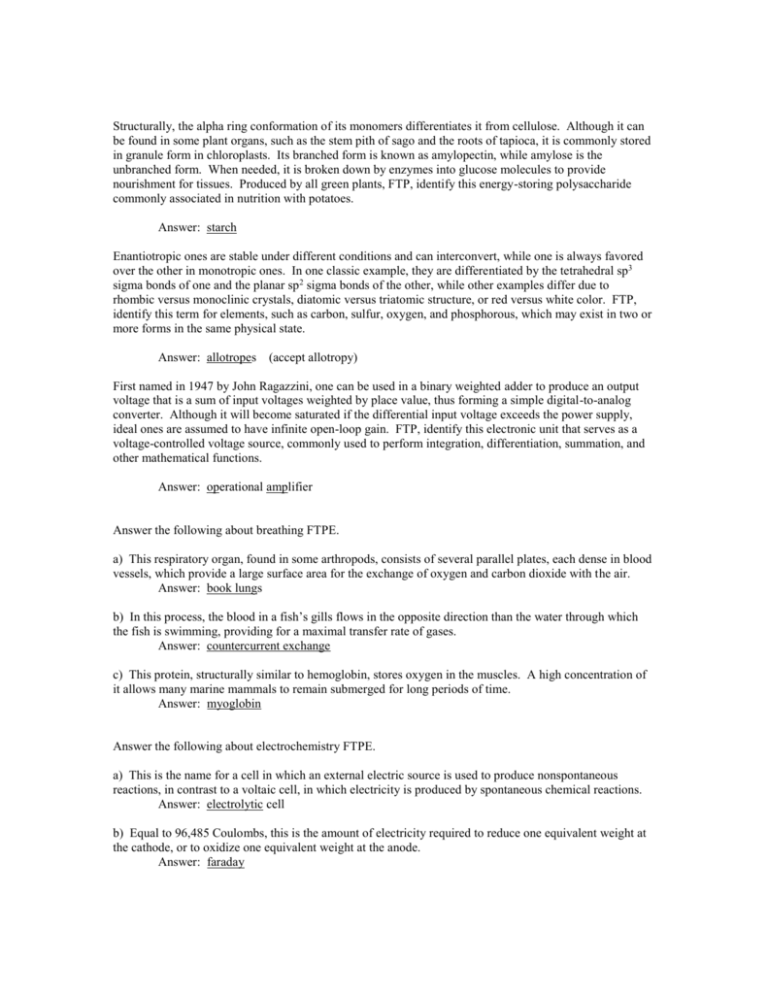Oct03 Science - Collegiate Quizbowl Packet Archive
advertisement

Structurally, the alpha ring conformation of its monomers differentiates it from cellulose. Although it can be found in some plant organs, such as the stem pith of sago and the roots of tapioca, it is commonly stored in granule form in chloroplasts. Its branched form is known as amylopectin, while amylose is the unbranched form. When needed, it is broken down by enzymes into glucose molecules to provide nourishment for tissues. Produced by all green plants, FTP, identify this energy-storing polysaccharide commonly associated in nutrition with potatoes. Answer: starch Enantiotropic ones are stable under different conditions and can interconvert, while one is always favored over the other in monotropic ones. In one classic example, they are differentiated by the tetrahedral sp3 sigma bonds of one and the planar sp2 sigma bonds of the other, while other examples differ due to rhombic versus monoclinic crystals, diatomic versus triatomic structure, or red versus white color. FTP, identify this term for elements, such as carbon, sulfur, oxygen, and phosphorous, which may exist in two or more forms in the same physical state. Answer: allotropes (accept allotropy) First named in 1947 by John Ragazzini, one can be used in a binary weighted adder to produce an output voltage that is a sum of input voltages weighted by place value, thus forming a simple digital-to-analog converter. Although it will become saturated if the differential input voltage exceeds the power supply, ideal ones are assumed to have infinite open-loop gain. FTP, identify this electronic unit that serves as a voltage-controlled voltage source, commonly used to perform integration, differentiation, summation, and other mathematical functions. Answer: operational amplifier Answer the following about breathing FTPE. a) This respiratory organ, found in some arthropods, consists of several parallel plates, each dense in blood vessels, which provide a large surface area for the exchange of oxygen and carbon dioxide with the air. Answer: book lungs b) In this process, the blood in a fish’s gills flows in the opposite direction than the water through which the fish is swimming, providing for a maximal transfer rate of gases. Answer: countercurrent exchange c) This protein, structurally similar to hemoglobin, stores oxygen in the muscles. A high concentration of it allows many marine mammals to remain submerged for long periods of time. Answer: myoglobin Answer the following about electrochemistry FTPE. a) This is the name for a cell in which an external electric source is used to produce nonspontaneous reactions, in contrast to a voltaic cell, in which electricity is produced by spontaneous chemical reactions. Answer: electrolytic cell b) Equal to 96,485 Coulombs, this is the amount of electricity required to reduce one equivalent weight at the cathode, or to oxidize one equivalent weight at the anode. Answer: faraday c) This limiting law, later modified by Lars Onsager to account for electrophoretic effects, attempts to model the differences of electrolytic solutions from ideal solutions by accounting for ion interactions. Answer: Debye-Huckel limiting law We’re going to really make you work for your points on this bonus. Answer the following about work for the stated number of points each. a) F5P, the amount of work done by a force in displacing a particle can be calculated as the change in this property of the particle, defined as one-half the product of the mass and the square of the velocity. Answer: kinetic energy (prompt on partial answer) b) FTP, this quantity is defined as the time rate of doing work. Answer: power c) FTP, in thermodynamics, the change in this quantity during a process is equal to the maximum work accompanying the process. It is often represented by a capital A, from the German word for work, Arbeit. Answer: Helmholtz energy d) FTP, this property, often attributed to hydrogen bonding, is the constant of proportionality for the amount of work required to change the area at the perimeter of a liquid by a given amount Answer: surface tension











